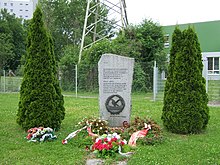Linz I subcamp
The concentration camp Linz I was a satellite camp of the Mauthausen concentration camp and existed from January 11, 1943 to August 3, 1944 in Linz at the Hermann Göring Reichswerke . A total of 1700 prisoners were sent to the camp. Over 120 prisoners in the Linz I camp died, most of them in an air raid in July 1944. The prisoners had to make building materials from blast furnace slag. They were also used in road construction and steel mills.
history
founding
The Reichswerke Hermann Göring reached an agreement with the SS to recycle the blast furnace slag from the Linz smelter, which was built immediately after the so-called annexation of Austria in 1938 until it was put into operation in autumn 1941 . Initially, it was planned to found a company with 50 percent stake each from the SS and the Reichswerke Hermann Göring to process the blast furnace slag. However, after long negotiations, this plan was rejected. The operation for the slag processing was operated entirely by the SS-owned company Deutsche Erd- und Steinwerke . The role of the Reichswerke Hermann Göring was limited to the financing of the factory as well as the set-up costs of the concentration camp and the delivery and delivery of the slag or the building materials produced.
The first 30 prisoners came to the premises of the Reichswerke Hermann Göring in December 1942 and prepared the construction of the camp. The first transport of 100 mostly Yugoslav prisoners arrived on January 11, 1943, the day the satellite camp was officially founded.
closure
In 1944 it was planned to significantly expand the use of prisoners at the Hermann Göring Reichswerke. The existing Linz I camp was too small for that. The new Linz III subcamp was therefore built not far from the original camp in May 1944 (in the meantime, the Linz II subcamp was built in downtown Linz , where prisoners had to build air raid tunnels). On July 25th there was a large Allied air raid on the Reichswerke. During this, the Linz I camp was almost completely destroyed. Over 120 prisoners died in this attack. The remaining prisoners were transferred to the new Linz III camp and the Linz I camp officially closed on August 3, 1944.
Prisoners
A total of 1,756 prisoners were deported to the Linz I camp. The peak was reached in July 1944 with around 950 prisoners. The 631 prisoners who survived the air raid in July 1944 were transferred to the newly established Linz III camp. Over 120 prisoners died in this air raid. Another eight deaths are recorded for the Linz I camp. Numerous weak and sick prisoners were returned to the Mauthausen camp.
The largest groups of prisoners came from Poland, Yugoslavia, the Soviet Union and the German Reich.
Living and working conditions
The prisoners were housed in four prisoner barracks, which they had to build themselves, on the premises of the hut , on a raised area between the plant and the Danube. Most of the prisoners had to work outdoors. This led to difficult working conditions, especially in winter and midsummer. As in most of the Mauthausen satellite camps, the prisoners were insufficiently fed. In the course of the poor working conditions, there were also repeated accidents at work.
Guarding
The command leader of Linz I was SS-Obersturmführer Fritz Miroff. Before that, he was used in the Mauthausen , Gusen and Bretstein camps. Miroff was sentenced to death in a side trial of the main Dachau Mauthausen trial and executed in November 1948. The report leader was SS-Oberscharführer Hermann Sturm, who was sentenced to 20 years in prison after the war. All guards were housed in a barrack next to the camp site.
Post war history
On the site of the former Linz III camp , a memorial stone from the Amicale de Mauthausen from 1965 commemorates the victims of the Linz I and Linz III camps. The voestalpine also operates the History Museum , which also houses the forced labor of concentration camp prisoners is handled by Linz I.
See also
- Mauthausen concentration camp
- Subcamp Linz III
- List of the Mauthausen subcamps
- Reichswerke Hermann Göring
literature
- Bertrand Perz : Linz I. In: Wolfgang Benz , Barbara Distel (Hrsg.): The place of terror. History of the National Socialist Concentration Camps. Vol. 4: Flossenbürg, Mauthausen, Ravensbrück. CH Beck, Munich 2006, pp. 392-394, ISBN 3-406-52964-X .
- Bertrand Perz: Concentration camp prisoners as forced laborers for the Reichswerke “Hermann Göring” in Linz. In: Oliver Rathkolb (Ed.): Nazi forced labor: The Linz location of the Reichswerke Hermann Göring AG Berlin 1938–1945. Volume 1: Forced labor - slave labor: Political, social and economic history studies. Böhlau, Vienna / Cologne / Weimar 2001, pp. 449-590, ISBN 3-205-99417-5 .
Web links
- Mauthausen Concentration Camp Memorial: Linz I
- Mauthausen-Guides MKÖ: Subcamp Linz I
- Contemporary history museum voestalpine
Individual evidence
- ↑ a b c d e f g Bertrand Perz: Linz I. In: Wolfgang Benz, Barbara Distel (Hrsg.): The place of terror. History of the National Socialist Concentration Camps. Vol. 4: Flossenbürg, Mauthausen, Ravensbrück. CH Beck, Munich 2006, pp. 392-394, ISBN 3-406-52964-X .
- ↑ a b c d The satellite camps. In: Mauthausen Concentration Camp Memorial. Retrieved May 29, 2020 .
- ↑ a b Linz subcamp I. In: Mauthausen Guides - Mauthausen Committee Austria. Retrieved May 28, 2020 .
Coordinates: 48 ° 16 ′ 20.6 ″ N , 14 ° 21 ′ 26.3 ″ E

